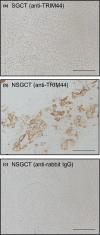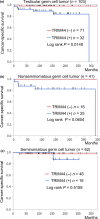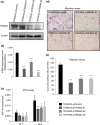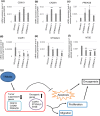A novel prognostic factor TRIM44 promotes cell proliferation and migration, and inhibits apoptosis in testicular germ cell tumor
- PMID: 27754579
- PMCID: PMC5276827
- DOI: 10.1111/cas.13105
A novel prognostic factor TRIM44 promotes cell proliferation and migration, and inhibits apoptosis in testicular germ cell tumor
Abstract
Tripartite motif 44 (TRIM44) is one of the TRIM family proteins that are involved in ubiquitination and degradation of target proteins by modulating E3 ubiquitin ligases. TRIM44 overexpression has been observed in various cancers. However, its association with testicular germ cell tumor (TGCT) is unknown. We aimed to investigate the clinical significance of TRIM44 and its function in TGCT. High expression of TRIM44 was significantly associated with α feto-protein levels, clinical stage, nonseminomatous germ cell tumor (NSGCT), and cancer-specific survival (P = 0.0009, P = 0.0035, P = 0.0004, and P = 0.0140, respectively). Multivariate analysis showed that positive TRIM44 IR was an independent predictor of cancer-specific mortality (P = 0.046). Gain-of-function study revealed that overexpression of TRIM44 promoted cell proliferation and migration of NTERA2 and NEC8 cells. Knockdown of TRIM44 using siRNA promoted apoptosis and repressed cell proliferation and migration in these cells. Microarray analysis of NTERA2 cells revealed that tumor suppressor genes such as CADM1, CDK19, and PRKACB were upregulated in TRIM44-knockdown cells compared to control cells. In contrast, oncogenic genes including C3AR1, ST3GAL5, and NT5E were downregulated in those cells. These results suggest that high expression of TRIM44 is associated with poor prognosis and that TRIM44 plays significant role in cell proliferation, migration, and anti-apoptosis in TGCT.
Keywords: Apoptosis; TRIM family; immunohistochemistry; microarray; testicular germ cell tumor.
© 2016 The Authors. Cancer Science published by John Wiley & Sons Australia, Ltd on behalf of Japanese Cancer Association.
Figures






References
-
- Albers P, Albrecht W, Algaba F et al European Association of Urology. Guidelines on testicular cancer. [Cited 13 June 2015.] Available from URL: http://uroweb.org/guideline/testicular-cancer.
-
- Hatakeyama S. TRIM proteins and cancer. Nat Rev 2011; 11: 792–804. - PubMed
-
- Ikeda K, Inoue S. TRIM proteins as RING finger E3 ubiquitin ligases. Adv Exp Med Biol 2012; 770: 27–37. - PubMed
-
- Wang Y, He D, Yang L et al TRIM26 functions as a novel tumor suppressor of hepatocellular carcinoma and its down regulation contributes to worse prognosis. Biochem Biophys Res Commun 2015; 463: 458–65. - PubMed
MeSH terms
Substances
Supplementary concepts
LinkOut - more resources
Full Text Sources
Other Literature Sources
Medical
Research Materials
Miscellaneous

